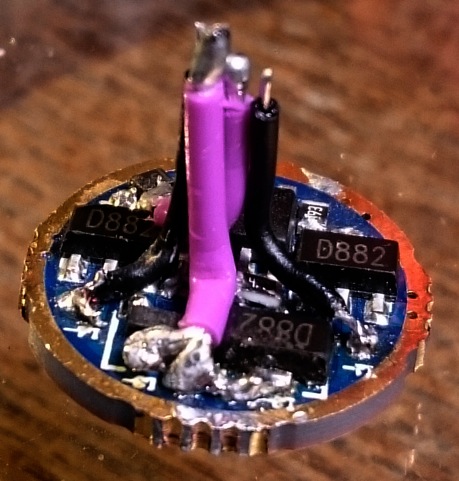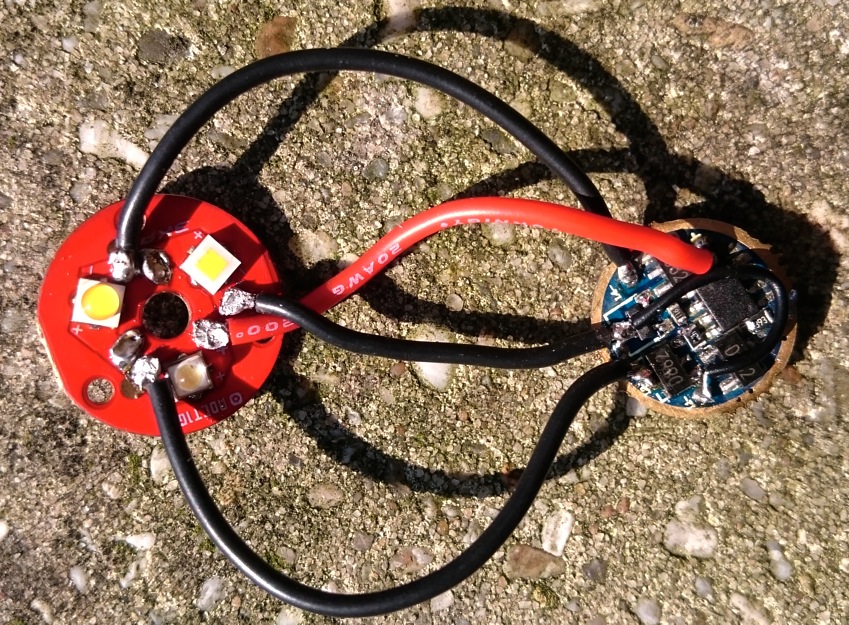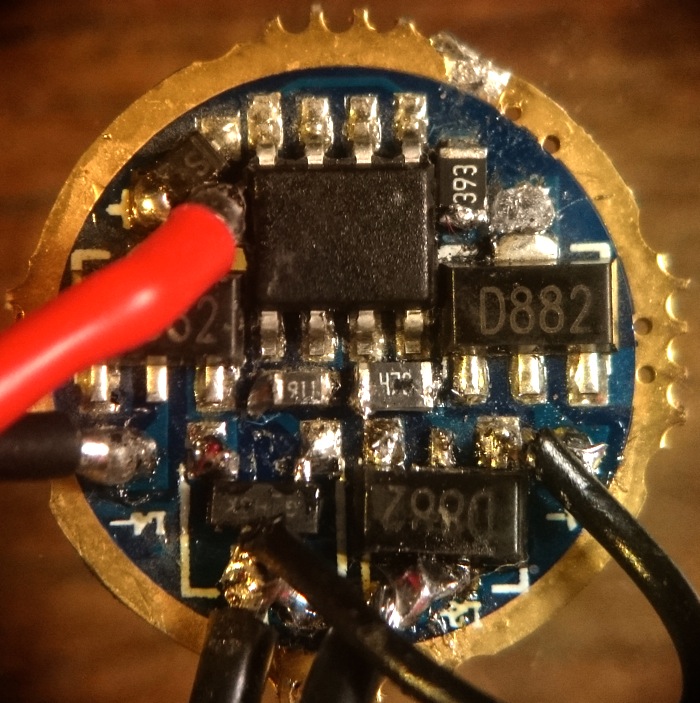I finished the mod with this driver!
The host is a Convoy S2+ with rubber boot (I like the rubber boot version better than the metal switch one, it looks nicer and the clicky feels better), in fact the host that came as the 365nm Nichia S2+ that was a good deal at Banggood a few weeks ago. I salvaged the UV-led for another test one of these days. I ordered separately two black shorty tubes from Simon, but today I found that the one tube that I had leftover from ReManG's group fitted the S2+, I just had to roughen up the threading on the head-side a bit to have it make electrical contact.
On the driver I changed the modes that I described above a bit (by relocating some wires and swapping a resistor on channel 4 from 39KOhm to 911 Ohm) to make the UI still more to my liking. Now the UI starts with 5lumen low on the amber led, then 60 lumen on the WW XP-L Hi, then 700 lumen on the XP-L Hi, last 160 lumen on the 96CRI 4500K SSL80 led. I ran out of 22AWG teflon wire, so I bought a new batch on ebay, from now on many mods will have purple wires! :-)

The mod is basically the same mod as the second red S2+ that I did lately, in short: it is a Convoy S2+ shorty that accomodates a 18500 battery, the extra space was created by using triple optics, triple Noctigon, drastically shortened pill by cutting off the led-shelf and much of the threading so that there's only just enough space inside for the driver, soldered a 1mm copper disc on top as a new led-shelf, soldered the triple Noctigon on top of that. The springs are intl-outdoor CU-Beryllium springs, but the one on the driver side was made smaller by cutting one complete turn off the wire. The glass lens was kept in place before the optic.
Of course not all modding went smoothly, everything had to be re-done at least once, and the worst what happened was that the driver seemed dead at a certain point, and I spent two hours trying to find the fault, gave up, tried again and found that the led+ pad was right next to the MCU and that it shorted to an invisible but apparently exposed pad under the chip :tired:
The netto result looks like this:


I'm really glad with the result! The UI is channel1->channel2->channel3->channel4->3boringblinkymodes. The blinkies would be annoying but because the driver resets after a pretty short half-long press (1 second) , from all modes you can directly get to start again. This is what's finally on the channels:
| channel nr |
resistor value between MCU and transistor |
the led that is wired to this channel |
tail-current on a Sanyo 1700mAh 18500 |
output measured in integrating sphere |
runtime on a 1700mAh Sanyo 18500 battery |
| 1 |
39 kOhm |
ProLight PK2N pc-amber |
27 mA |
5.5 lumen |
2.5 days |
| 2 |
4.7 kOhm |
XP-L HI U4 7A1 3000K |
240 mA |
68 lumen |
7 hours |
| 3 |
455 Ohm (transistor swapped with FET) |
XP-L HI U4 7A1 3000K |
3.5 A |
700 lumen |
30 minutes |
| 4 |
910 Ohm |
Oslon SSL80 4500K 96CRI |
1.0 A |
185 lumen |
1.7 hours |
So the 5.5 lumen low is now done by the pc-amber led, what feels right and is useful as a night-stand light, the x10 mode spacing to mid and to high is exactly what I like best (700 lumen in warm white :love: ), and the SSL80 96CRI led is good for seeing true colours if that is needed.
*The high setting is not sustainable, after a minute it gets too hot to hold.
*I do not like the beam of the XP-L HI through the Carclo very much, it is a bit square-ish. Works fine no problem, but it is not perfect.
*The SSL80 beam is a bit off-center, again fine but not a perfect beam. The led must have been reflowed just a bit off the center on the solder pads.
*all modes are true current without PWM, so the efficiency on the low modes is as good as it can be.
As a FYI, I tried a lighted tailcap with this driver (with warm white leds in the tail I would have a real moon-mode on top of the UI), soldered a 470 Ohm bleeder resistor and screwed on the lighted tailcap of my red S2+ to check. Well, it does not work, the reset time after switch-off gets really really short, so that any mode change attempt turns into a reset to channel1. So I called it a day and removed the bleeder again.
I have one more mod using this driver in the planning, with the four channels all on the same led, so not a triple. Resistor tweaking on channels 1-2-3 and a FET on channel 4, I think a LFPAK33 FET will swap right in too. The currents will be 6mA->60mA->600mA->direct drive.





